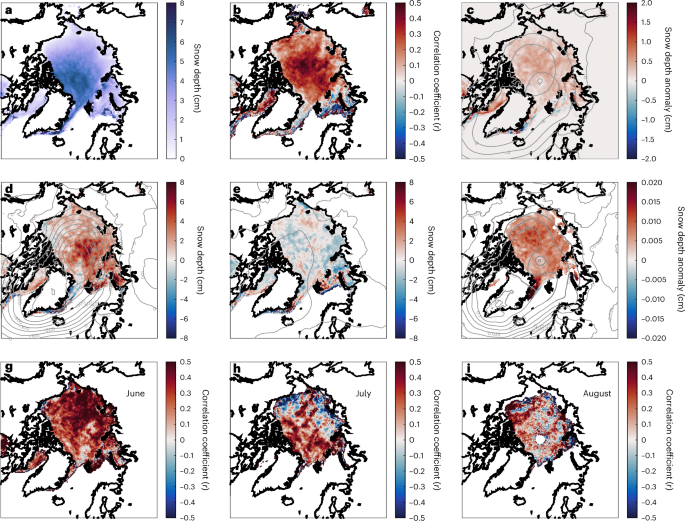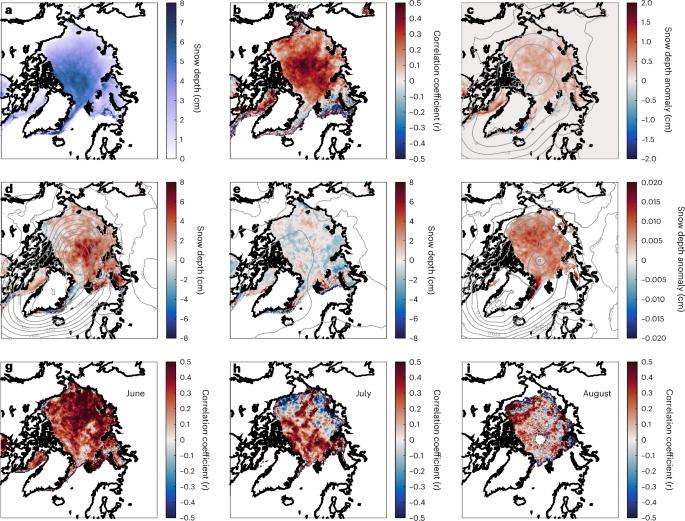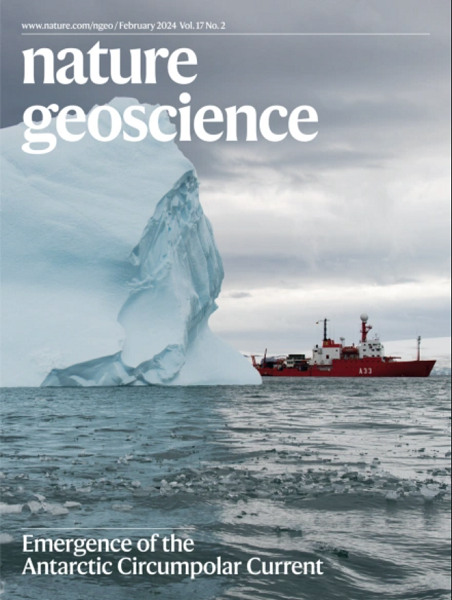Summer snow on Arctic sea ice modulated by the Arctic Oscillation
IF 15.7
1区 地球科学
Q1 GEOSCIENCES, MULTIDISCIPLINARY
引用次数: 0
Abstract
Since the 1970s, Arctic sea ice has undergone unprecedented change, becoming thinner, less extensive and less resilient to summer melt. Snow’s high albedo greatly reduces solar absorption in sea ice and the upper ocean, which mitigates sea–ice melt and ocean warming. However, the drivers of summertime snow depth variability are unknown. The Arctic Oscillation is a mode of natural climate variability, influencing Arctic snowfall and air temperatures. Thus, it may affect summertime snow conditions on Arctic sea ice. Here we examine the role of the Arctic Oscillation in summer snow depth variability on Arctic sea ice in 1980–2020 using atmospheric reanalysis, snow modelling and satellite data. The positive phase leads to greater snow accumulation, ranging up to ~4.5 cm near the North Pole, and higher surface albedo in summer. There are more intense, frequent Arctic cyclones, cooler temperatures aloft and greater snowfall relative to negative and neutral phases; these conditions facilitate a more persistent summer snow cover, which may lessen sea-ice melt and ocean warming. The Arctic Oscillation influence on summertime snow weakens after 2007, which suggests that future warming and Arctic sea-ice loss might modify the relationship between the Arctic Oscillation and snow on Arctic sea ice. Summer snow accumulation and its albedo effect on Arctic sea ice are controlled by the Arctic Oscillation atmospheric circulation pattern, according to a combined modelling and remote sensing analysis.


北极海冰上的夏季积雪受北极涛动的影响
自 20 世纪 70 年代以来,北极海冰发生了前所未有的变化,变得越来越薄,面积越来越小,抵御夏季融化的能力也越来越弱。雪的高反照率大大减少了海冰和海洋上层对太阳的吸收,从而缓解了海冰融化和海洋变暖。然而,夏季雪深变化的驱动因素尚不清楚。北极涛动是一种自然气候变异模式,会影响北极降雪量和气温。因此,它可能会影响北极海冰夏季的积雪情况。在此,我们利用大气再分析、雪模型和卫星数据研究了 1980-2020 年北极涛动在北极海冰夏季积雪深度变化中的作用。正态势导致积雪增加,在北极附近可达 ~4.5 厘米,夏季表面反照率较高。相对于负相位和中性相位,北极气旋更强烈、更频繁,高空温度更低,降雪量更大;这些条件有利于更持久的夏季积雪覆盖,从而可能减少海冰融化和海洋变暖。北极涛动对夏季积雪的影响在 2007 年后减弱,这表明未来气候变暖和北极海冰消失可能会改变北极涛动与北极海冰积雪之间的关系。
本文章由计算机程序翻译,如有差异,请以英文原文为准。
求助全文
约1分钟内获得全文
求助全文
来源期刊

Nature Geoscience
地学-地球科学综合
CiteScore
26.70
自引率
1.60%
发文量
187
审稿时长
3.3 months
期刊介绍:
Nature Geoscience is a monthly interdisciplinary journal that gathers top-tier research spanning Earth Sciences and related fields.
The journal covers all geoscience disciplines, including fieldwork, modeling, and theoretical studies.
Topics include atmospheric science, biogeochemistry, climate science, geobiology, geochemistry, geoinformatics, remote sensing, geology, geomagnetism, paleomagnetism, geomorphology, geophysics, glaciology, hydrology, limnology, mineralogy, oceanography, paleontology, paleoclimatology, paleoceanography, petrology, planetary science, seismology, space physics, tectonics, and volcanology.
Nature Geoscience upholds its commitment to publishing significant, high-quality Earth Sciences research through fair, rapid, and rigorous peer review, overseen by a team of full-time professional editors.
 求助内容:
求助内容: 应助结果提醒方式:
应助结果提醒方式:


